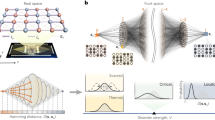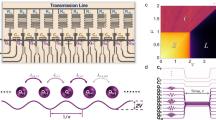Abstract
Quantum many-body scarring (QMBS) is a recently discovered form of weak ergodicity breaking in strongly interacting quantum systems, which presents opportunities for mitigating thermalization-induced decoherence in quantum information processing applications. However, the existing experimental realizations of QMBS are based on systems with specific kinetic constrains. Here we experimentally realize a distinct kind of QMBS by approximately decoupling a part of the many-body Hilbert space in the computational basis. Utilizing a programmable superconducting processor with 30 qubits and tunable couplings, we realize Hilbert space scarring in a non-constrained model in different geometries, including a linear chain and quasi-one-dimensional comb geometry. By reconstructing the full quantum state through quantum state tomography on four-qubit subsystems, we provide strong evidence for QMBS states by measuring qubit population dynamics, quantum fidelity and entanglement entropy after a quench from initial unentangled states. Our experimental findings broaden the realm of scarring mechanisms and identify correlations in QMBS states for quantum technology applications.
This is a preview of subscription content, access via your institution
Access options
Access Nature and 54 other Nature Portfolio journals
Get Nature+, our best-value online-access subscription
$29.99 / 30 days
cancel any time
Subscribe to this journal
Receive 12 print issues and online access
$209.00 per year
only $17.42 per issue
Buy this article
- Purchase on Springer Link
- Instant access to full article PDF
Prices may be subject to local taxes which are calculated during checkout




Similar content being viewed by others
Data availability
The data that support the findings of this study are available at https://doi.org/10.5518/1204.
Code availability
All the relevant source codes are available from the corresponding authors upon reasonable request.
References
Ladd, T. D. et al. Quantum computers. Nature 464, 45–53 (2010).
Georgescu, I. M., Ashhab, S. & Nori, F. Quantum simulation. Rev. Mod. Phys. 86, 153–185 (2014).
Mi, X. et al. Information scrambling in computationally complex quantum circuits. Science 374, 1479–1483 (2021).
Arute, F. et al. Quantum supremacy using a programmable superconducting processor. Nature 574, 505–510 (2019).
Swingle, B., Bentsen, G., Schleier-Smith, M. & Hayden, P. Measuring the scrambling of quantum information. Phys. Rev. A 94, 040302 (2016).
Xu, K. et al. Emulating many-body localization with a superconducting quantum processor. Phys. Rev. Lett. 120, 050507 (2018).
Landsman, K. A. et al. Verified quantum information scrambling. Nature 567, 61–65 (2019).
Morong, W. et al. Observation of Stark many-body localization without disorder. Nature 599, 393–398 (2021).
Deutsch, J. M. Quantum statistical mechanics in a closed system. Phys. Rev. A 43, 2046–2049 (1991).
Srednicki, M. Chaos and quantum thermalization. Phys. Rev. E 50, 888–901 (1994).
Rigol, M., Dunjko, V. & Olshanii, M. Thermalization and its mechanism for generic isolated quantum systems. Nature 452, 854–858 (2008).
Kaufman, A. M. et al. Quantum thermalization through entanglement in an isolated many-body system. Science 353, 794–800 (2016).
Bluvstein, D. et al. Controlling quantum many-body dynamics in driven Rydberg atom arrays. Science 371, 1355–1359 (2021).
Serbyn, M., Abanin, D. A. & Papić, Z. Quantum many-body scars and weak breaking of ergodicity. Nat. Phys. 17, 675–685 (2021).
Moudgalya, S., Bernevig, B. A. & Regnault, N. Quantum many-body scars and Hilbert space fragmentation: a review of exact results. Rep. Prog. Phys. 85, 086501 (2022).
Heller, E. J. Bound-state eigenfunctions of classically chaotic Hamiltonian systems: scars of periodic orbits. Phys. Rev. Lett. 53, 1515–1518 (1984).
Nandkishore, R. & Huse, D. A. Many-body localization and thermalization in quantum statistical mechanics. Annu. Rev. Condens. Matter Phys. 6, 15–38 (2015).
Abanin, D. A., Altman, E., Bloch, I. & Serbyn, M. Colloquium: many-body localization, thermalization, and entanglement. Rev. Mod. Phys. 91, 021001 (2019).
Guo, Q. et al. Stark many-body localization on a superconducting quantum processor. Phys. Rev. Lett. 127, 240502 (2021).
Guo, Q. et al. Observation of energy-resolved many-body localization. Nat. Phys. 17, 234–239 (2021).
Omran, A. et al. Generation and manipulation of Schrödinger cat states in Rydberg atom arrays. Science 365, 570–574 (2019).
Dooley, S. Robust quantum sensing in strongly interacting systems with many-body scars. PRX Quantum 2, 020330 (2021).
Shiraishi, N. & Mori, T. Systematic construction of counterexamples to the eigenstate thermalization hypothesis. Phys. Rev. Lett. 119, 030601 (2017).
Moudgalya, S., Regnault, N. & Bernevig, B. A. Entanglement of exact excited states of Affleck-Kennedy-Lieb-Tasaki models: exact results, many-body scars, and violation of the strong eigenstate thermalization hypothesis. Phys. Rev. B 98, 235156 (2018).
Schecter, M. & Iadecola, T. Weak ergodicity breaking and quantum many-body scars in spin-1 XY magnets. Phys. Rev. Lett. 123, 147201 (2019).
Moudgalya, S., Bernevig, B. A. & Regnault, N. Quantum many-body scars in a Landau level on a thin torus. Phys. Rev. B 102, 195150 (2020).
McClarty, P. A., Haque, M., Sen, A. & Richter, J. Disorder-free localization and many-body quantum scars from magnetic frustration. Phys. Rev. B 102, 224303 (2020).
van Voorden, B., Minář, J. & Schoutens, K. Quantum many-body scars in transverse field Ising ladders and beyond. Phys. Rev. B 101, 220305 (2020).
Hart, O., De Tomasi, G. & Castelnovo, C. From compact localized states to many-body scars in the random quantum comb. Phys. Rev. Res. 2, 043267 (2020).
Zhao, H., Vovrosh, J., Mintert, F. & Knolle, J. Quantum many-body scars in optical lattices. Phys. Rev. Lett. 124, 160604 (2020).
Kuno, Y., Mizoguchi, T. & Hatsugai, Y. Flat band quantum scar. Phys. Rev. B 102, 241115 (2020).
O’Dea, N., Burnell, F., Chandran, A. & Khemani, V. From tunnels to towers: quantum scars from Lie algebras and q-deformed Lie algebras. Phys. Rev. Res. 2, 043305 (2020).
Desaules, J.-Y., Hudomal, A., Turner, C. J. & Papić, Z. Proposal for realizing quantum scars in the tilted 1D Fermi-Hubbard model. Phys. Rev. Lett. 126, 210601 (2021).
Ren, J., Liang, C. & Fang, C. Quasisymmetry groups and many-body scar dynamics. Phys. Rev. Lett. 126, 120604 (2021).
Fendley, P., Sengupta, K. & Sachdev, S. Competing density-wave orders in a one-dimensional hard-boson model. Phys. Rev. B 69, 075106 (2004).
Lesanovsky, I. & Katsura, H. Interacting Fibonacci anyons in a Rydberg gas. Phys. Rev. A 86, 041601 (2012).
Bernien, H. et al. Probing many-body dynamics on a 51-atom quantum simulator. Nature 551, 579–584 (2017).
Su, G.-X. et al. Observation of unconventional many-body scarring in a quantum simulator. Preprint at https://arxiv.org/abs/2201.00821 (2022).
Jepsen, P. N. et al. Long-lived phantom helix states in Heisenberg quantum magnets. Nat. Phys. 18, 899–904 (2022).
Su, W. P., Schrieffer, J. R. & Heeger, A. J. Solitons in polyacetylene. Phys. Rev. Lett. 42, 1698–1701 (1979).
Wu, Y. et al. Strong quantum computational advantage using a superconducting quantum processor. Phys. Rev. Lett. 127, 180501 (2021).
Krantz, P. et al. A quantum engineer’s guide to superconducting qubits. Appl. Phys. Rev. 6, 021318 (2019).
Blais, A., Grimsmo, A. L., Girvin, S. M. & Wallraff, A. Circuit quantum electrodynamics. Rev. Mod. Phys. 93, 025005 (2021).
Jafari, R. & Johannesson, H. Loschmidt echo revivals: critical and noncritical. Phys. Rev. Lett. 118, 015701 (2017).
Najafi, K., Rajabpour, M. A. & Viti, J. Return amplitude after a quantum quench in the XY chain. J. Stat. Mech. 2019, 083102 (2019).
Maimaiti, W., Andreanov, A., Park, H. C., Gendelman, O. & Flach, S. Compact localized states and flat-band generators in one dimension. Phys. Rev. B 95, 115135 (2017).
Ho, W. W., Choi, S., Pichler, H. & Lukin, M. D. Periodic orbits, entanglement, and quantum many-body scars in constrained models: matrix product state approach. Phys. Rev. Lett. 122, 040603 (2019).
Desaules, J.-Y., Pietracaprina, F., Papić, Z., Goold, J. & Pappalardi, S. Extensive multipartite entanglement from SU(2) quantum many-body scars. Phys. Rev. Lett. 129, 020601 (2022).
Malvania, N. et al. Generalized hydrodynamics in strongly interacting 1D Bose gases. Science 373, 1129–1133 (2021).
Neill, C. et al. A blueprint for demonstrating quantum supremacy with superconducting qubits. Science 360, 195–199 (2018).
Acknowledgements
The device was fabricated at the Micro-Nano Fabrication Center of Zhejiang University. We acknowledge support from the National Natural Science Foundation of China (grant nos. 92065204, U20A2076, 11725419 and 12174342), the National Basic Research Program of China (grant no. 2017YFA0304300) and the Zhejiang Province Key Research and Development Program (grant no. 2020C01019). The work at Arizona State University is supported by AFOSR through grant no. FA9550-21-1-0186. Z.P. and J.Y.D. acknowledge support by EPSRC grants EP/R020612/1 and EP/R513258/1, and by Leverhulme Trust Research Leadership Award RL-2019-015. L.Y. is also supported by the Fundamental Research Funds for the Central Universities.
Author information
Authors and Affiliations
Contributions
L.Y. proposed the idea. L.Y., Y.-C.L., J.Y.D. and Z.P. developed the theory and numerical simulation. P.Z., H.D. and Y.G. performed the experiment, and H.L. and J.C. fabricated the device supervised by H.W. L.Z. and J.H. developed the measurement electronics. L.Y., H.W., Y.-C.L. and Z.P. co-wrote the manuscript. All the authors contributed to the experimental setup, discussions of the results and development of the manuscript.
Corresponding authors
Ethics declarations
Competing interests
The authors declare no competing interests.
Peer review
Peer review information
Nature Physics thanks the anonymous reviewers for their contribution to the peer review of this work
Additional information
Publisher’s note Springer Nature remains neutral with regard to jurisdictional claims in published maps and institutional affiliations.
Extended data
Extended Data Fig. 1 Experimental sequence diagram.
Sequence with strongly interacting many-body dynamics, where injecting a π pulse (red wave pulse) serves to lift the two-level qubit from the ground state to the excited state.
Supplementary information
Supplementary Information
Supplementary Figs. 1–20, Tables 1 and 2 and discussion.
Rights and permissions
Springer Nature or its licensor holds exclusive rights to this article under a publishing agreement with the author(s) or other rightsholder(s); author self-archiving of the accepted manuscript version of this article is solely governed by the terms of such publishing agreement and applicable law.
About this article
Cite this article
Zhang, P., Dong, H., Gao, Y. et al. Many-body Hilbert space scarring on a superconducting processor. Nat. Phys. 19, 120–125 (2023). https://doi.org/10.1038/s41567-022-01784-9
Received:
Accepted:
Published:
Issue Date:
DOI: https://doi.org/10.1038/s41567-022-01784-9
This article is cited by
-
The promises and challenges of many-body quantum technologies: A focus on quantum engines
Nature Communications (2024)
-
Observation of many-body Fock space dynamics in two dimensions
Nature Physics (2023)



